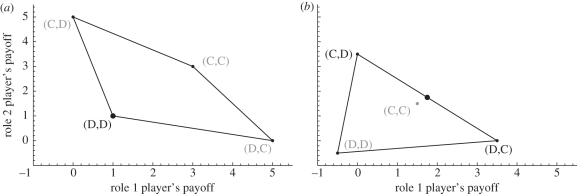Figure 1.
The payoff polygons for (a) the game Gℬℬ (the resident prisoner's dilemma behavioural game) and (b) the game Gℋℋ (the game between the heterozygotes). Each corner of the polygons corresponds to a different cell in the payoff matrix, identified by the combination of actions. The points in grey are non-equilibrium outcomes, they are not played as the result of individual play dynamics. The outcomes in black are the result of individual play for each game. In (a), only the (D,D) outcome is the NE, whereas in (b), both (D,C) and (C,D) are possible outcomes. The large black circle in each panel denotes the expected payoff from the game to each role. In (b), this is the average of the two NE. In (a), the Pareto boundary is made up of the two line segments (D,C)–(C,C) and (C,C)–(C,D); in (b), the Pareto boundary is the line segment between the two NE. Thus, the expected payoff from the game Gℋℋ lies on the Pareto boundary.

